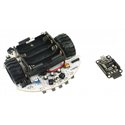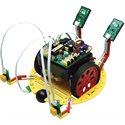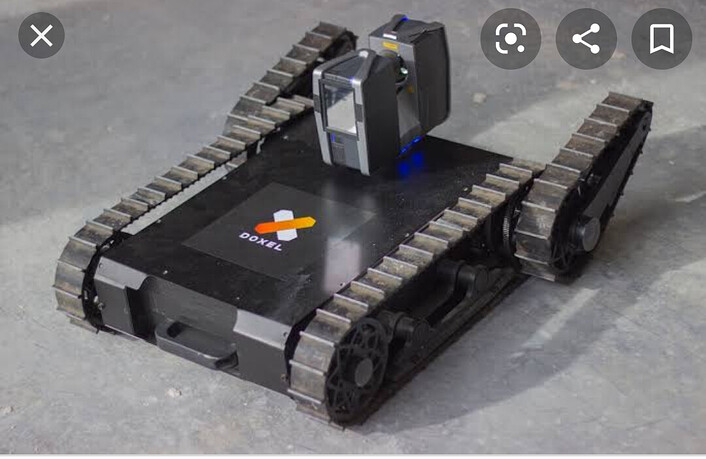You're thinking about building your first robot and have grandiose thoughts of making something like an exoskeleton or a giant robotic "pet" to strike fear into your enemies. As much as we dream about these robots and see them in movies, there are not many around for a reason. For your first build, you need a general sense of what you're getting yourself into and make informed decisions.
It is critically important to choose the size of your robot before you purchase any parts as it will have significant ramifications on all aspects of the design. As a rule of thumb, the weight of a robot can be divided into three segments: electronics, mechanics and battery. Because each mobile robotic design is unique, you can estimate 30 to 40% of the robot's weight will be in batteries alone, roughly 40% will be taken up by the mechanical frame, actuators and hardware and 2 to 20% for electronics. These numbers will undoubtedly vary depending on the type of robot and which category it falls into below.
Small Robots
If you are new to robotics and are looking to gain knowledge and experience without breaking the bank, this is the category for you. Small robots are generally considered to be less than ~3kg (6.6lbs) and are about the size of a human hand. These robots generally cost between $100 and $1000. Small sized robots are not necessarily restricted to indoor use and often have the benefit of being easily portable. Here's a possible breakdown for an average "small" sized robot:- Common Types: small wheeled and tracked robots, small legged robots, small aircraft and subs, small robot arms
- Frame: $5 to $200; made of plastic, cardboard or aluminum or wood in the case of UAVs
- "Brain": $10 to $500; simple but capable hobby-grade microcontroller, smart phone or netbook PC.
- Motor Controller: $10 to $200; can be a simple low current motor controller or servo controller
- Motors: $5 to $100 each; 2x small gear motors for mobile robots, more if you are considering a legged robot
- Battery: $5 to $200; NiMh or LiPo (both are rechargeable). These are usually 3.7V to 12V and ~1000mAh.
- Sensors: $5 to $200; most people are happy with some distance sensors, encoders etc.
- Build time: a few weeks
Medium
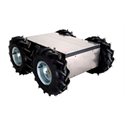



Medium sized robots are generally considered to be between about 3kg and 20kg (6.6 to 44lbs). Because of their size, medium robots are capable of carrying increased payload, the cost of these robots can vary tremendously, but usually average $500 to $12,000. An example of a medium sized robot is the Coroware Development Platform.
- Common Types: 4WD or 6WD, Tracks, some robotic arms
- Frame: $200 to $2000; made of plastic and aluminum
- "Brain": $50 to $500; This can be a microcontroller to a single board computer, or even a laptop.
- Motor Controller: $50 to $800; The cost of the controller increases in proportion to the weight of the robot.
- Motors: $50 to $200 each; You usually need 4x small gear motors for mobile wheeled robots. You don't see many legged robots in this range since many motors cost a lot of money.
- Battery: $20 to $500; NiMh, LiPo or more exotic (for lighter weight). These are higher capacity and usually higher voltage.
- Sensors: $100 to $500; Aside from the normal variety of sensors, you can get into more "exotic" such as laser rangefinders.
- Build time: several weeks to several months
Large
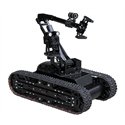



Large sized robots are ~20kg (44lbs) or more. They require larger and more costly motors and motor controllers. These robots can include industrial robots, de-mining and surveillance and even small electric vehicles. These robots require very robust frames and often include redundant systems. Prototypes cost several thousand to several million dollars (for research or military prototypes).
- Common Types: 4WD or 6WD, Tracks, some robotic arms
- Frame: $1000 to $3000; made of aluminum or other metals
- "Brain": $500+; This is usually a computer (if you need ones that can withstand vibrations, temperature etc. they cost much more).
- Motor Controller: $1000 range (if you're considering a combustion engine, you'll need to modify a transmission).
- Motors: $200+ each; two to four large gear motors for mobile robots, depending on how much payload you want to transport, or one gear motor per degree of freedom.
- Battery: $200+ (can even be a combustion engine at this stage)
- Sensors: $2000+; Your machine is now dangerous and it needs to know everything that's going on around it - laser rangefinders or other 2D / 3D detection sensors are required.
- Build time: months...
This is a companion discussion topic for the original entry at https://community.robotshop.com/tutorials/show/how-big-can-i-make-my-robot



